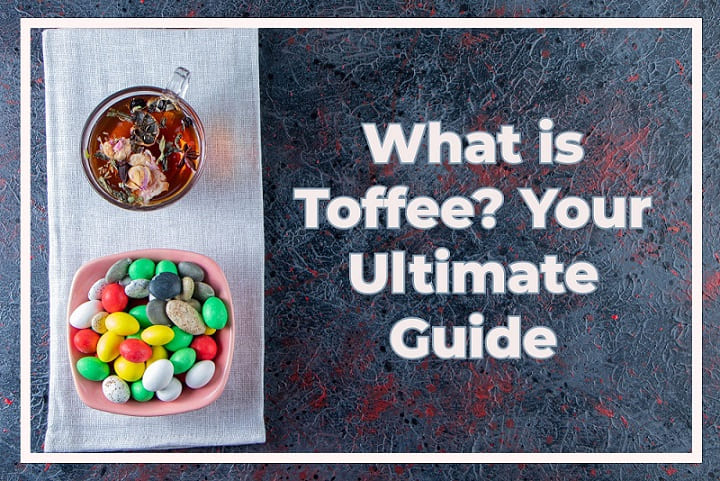![]()
When you crave something sweet, what comes to mind? Perhaps, toffee.
You cannot escape toffee’s rich, buttery sweetness and delightful, crunchy texture. We all are familiar with toffee’s taste, but do we know what exactly it is and what ingredients and steps go into making it? If not, here’s your chance.
What is Toffee?
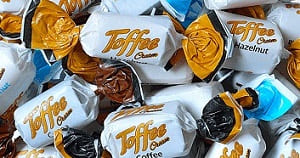
Toffee is a confection that tempts and delights as an everyday snack or a special treat. Its hard and chewy texture distinguishes it from your average candy. The core ingredient is sugar mixed with butter that’s caramelized at around 149 to 154 °C (300 to 310 °F) through precise temperature control. Usually, flour, cream, milk, nuts, raisins, and other enhancements go into the mix for flavor and texture. Toffe is hard at first but melts upon chewing or sucking. Munch it solo or jazz up your favorite desserts with it, toffee always hits the spot. Plus, it’s cheap and readily available.
Toffee: Texture
Let’s get into the nitty-gritty of toffee’s defining feature, texture. An amazing mix of hardness, chewiness, buttery smoothness, and sweet stickiness – that’s toffee for you.
1. Hard and Crispy:
Toffee is hard but not hard enough to break your teeth. The outer layer will offer crispy resistance initially but caves in when you sink your teeth into it or keep it in your mouth for long enough.
2. Chewy Goodness:
Keep chewing and the toffee softens up, going from a solid block to something more bendy. It’s like a little journey for your taste buds — starting tough and ending up all pliable and delicious.
3. Buttery Smoothness:
What do you love the most about toffees? Perhaps, it is its buttery smoothness. Once the outer layer is gone, the buttery layer takes over, coating everything in a velvety, rich goodness.
4. Balanced Sweetness:
How can we forget the sticky sweetness? It’s sweet, but not sickly. The sugar’s all caramelized during cooking, giving it that gentle stickiness. Some toffees might come with a pinch of salt to balance it all.
5. Layered Richness:
Break a piece of toffee, and you’ll see the layered richness. There’s that crispy shell, a chewy middle, and sometimes extra layers like chocolate or nuts. It’s like a texture party in your mouth!
6. Temperature Matters:
Toffees are usually temperature-specific. Even the super hard cold toffee can turn into a gooey mess when left at room temperature.
Toffee: Ingredients & Flavors
There are core ingredients. Then, there are flavorings. Let’s break down the magic behind these sugary treats’ ingredients and flavors.
Core Ingredients:
1. Sugar: This is the star of the show, giving these dainties their sweet, caramelized flavor. You can use white sugar, brown sugar, or even molasses for extra richness.
2. Butter: It’s the secret to that velvety smooth texture. Unsalted butter is the norm but some go for clarified butter for that extra heat resistance.
3. Cream or milk (optional): If you’re aiming for extra richness and moisture, toss in some heavy cream, whole milk, or even condensed milk if you’re feeling fancy.
Flavorings:
1. Vanilla: A classic choice, vanilla extract adds sweetness and a hint of aroma.
2. Chocolate: Whether it’s bittersweet, semisweet, or milk chocolate, it brings that creamy, chocolatey goodness.
3. Nuts: Almonds, pecans, walnuts, peanuts—you name it! Toast ’em up for that extra crunch and nutty flavor.
4. Coffee: Need a pick-me-up? Throw in some instant coffee granules or brewed espresso for that mocha twist.
5. Spices: Get creative with cinnamon, nutmeg, ginger, or cardamom for a subtle flavor kick.
6. Citrus Zest: Zest things up with some finely grated lemon, orange, or lime for a fresh fruity twist.
7. Sea Salt: A pinch of sea salt balances out the sweetness.
8. Liqueurs: Feeling fancy? Splash in some rum, whiskey, or Bailey Irish cream for a boozy depth.
Toffee: Types
Toffee comes in all shapes and sizes to fit every taste, occasion, and need. Whether you’re into chewy, crunchy, buttery, or anything in between, there’s a toffee waiting to satisfy your sweet tooth. Here are a few popular variations.
1. English Toffee:
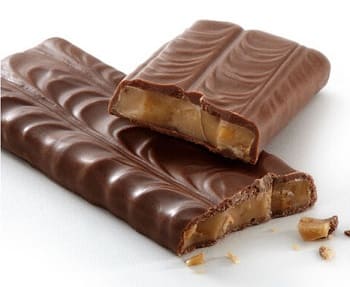
Image: Heath Toffee Bar
First, we’ve English Toffee, the classic version popular in the US. It’s buttery and often has almonds for extra crunch. You can find it in chewy and hard versions with a creamy core. Heath bar is a popular example of this variety.
2. Nut Toffee:
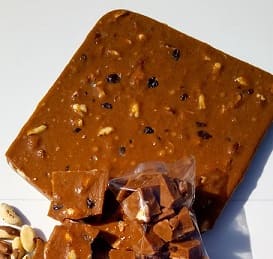
As the name says, it contains nuts like almonds, walnuts, and more. Just place it inside your mouth and experience a flavor explosion with a perfect balance of sweetness and crunch.
3. Chewy Toffee:
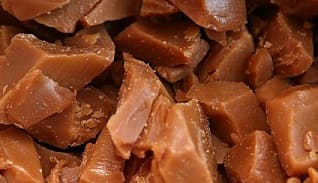
Cooked to a slightly lower temperature, it is a bit hard initially but flexible later. The crispy layer gives way to a chewy texture.
4. Honeycomb Toffee:
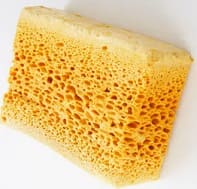
True to its name, it has a light, airy texture almost like a honeycomb. Popular in South Africa and Great Britain, it’s crispy on the outside, yet soft and spongey on the inside. Made of brown sugar, baking soda, and vinegar, it goes by several names – honeycomb candy, sponge toffee, cinder toffee, seafoam, and hokey pokey.
5. Scottish Tablet:
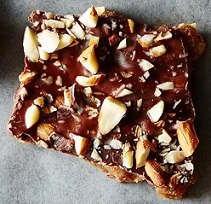
As the name suggests, the Scottish Tablet is a classic treat straight from Scotland. It’s sweet, buttery, and crumbly, made by boiling sugar, butter, semisweet chocolate, and almonds. You can swap chocolate for condensed milk to suit your taste. Either way, freezing is required before cutting to achieve that crunchy texture.
6. Puff Candy:
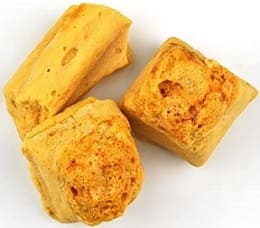
Puff Candy, also from Scotland, is like the cousin of honeycomb toffee. Light and airy, thanks to baking soda, it’s a delightful treat that’s as fun to eat as it is tasty. While puff toffees come with a brittle texture, Scottish tablet melts in your mouth. Unlike the grainy Scottish tablet, it is a tad bit harder, crunchier, and more chewable.
7. Golden Crunchers:
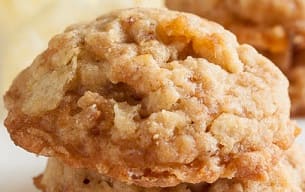
We’re not sure where they come from, but they’re crunchy, layered, and downright delicious. They treat you to the delectable concoction of buttery goodness, dark chocolate, and toasted almonds.
8. Maple Taffy:
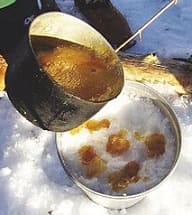
With maple syrup at its heart, Maple Taffy oozes intense sweetness, a rich, distinct maple flavor, a smooth buttery taste, and caramel undertones. Originating from Canada where Maple is part of life, it delivers a slight crunch due to the crystallized sugar before becoming smooth and velvety. They also call it “sugar on snow” and “candy on the snow.”
9. Toffee Chips:
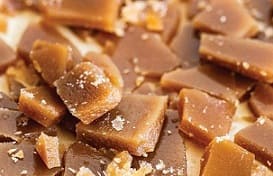
Make way for these delightful nuggets made from caramelized sugar or molasses mixed with butter. Also known as toffee bits, they are a variant of English toffee, just as sweet and nutty. When you munch on them, expect a satisfying crunch that gives way to a slight chewiness. Plus, they’re buttery smooth and just melt in your mouth as they warm up.
10. Coffee Toffee:
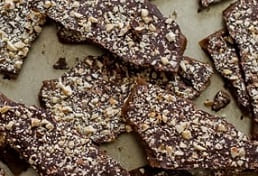
What do you get upon infusing coffee in a butter toffee? You guessed it right, coffee toffee. The flavorful and indulgent treat offers a kick of coffee, caramel undertones, and an amazing crunchy-chewy combo that melts in your mouth.
Difference Between Candy and Toffee:
Despite being used interchangeably, toffee and candy are two different things. Candy is an umbrella term for all things sweet. Toffee is a part of that umbrella, alongside hard candies, gummies, chocolates, and more. Different candies have different tastes, textures, and recipes. But toffee is a specific type of candy made from caramelized sugar, butter, cream, milk, and other natural ingredients. Unlike most candies, toffees are firm and brittle but soften when chewed. Read More
Top Toffee Brands in India:
In the lack of any credible sales data, we decided to be creative with our ranking of the top toffee brands in India. we used online searches to determine the leading brands. Accordingly, Parle Kismi is the most popular toffee brand with 4.6K online monthly searches as of March 2024. It is followed by Alpenliebe (3.2K searches), Pulse (3.2K searches), Melody (2.9K searches), Parle Kaccha Mango Bite (2.5K searches), and Parle Mango Bite (1.9K searches). Read More…
How to Make Toffee at Home?
Specifications may differ, but you can whip up a delightful sugary treat with these steps.
1. First off, gather all your goodies: sugar, butter, cream, nuts, and whatever enhancements you crave.
2. Now, toss that sugar into a heavy saucepan with water, milk, or cream, and let the sugar dissolve over low heat.
3. Crank up the heat and let it boil until it hits the hard crack stage, around 300-310°F (149-154°C).
4. Now, start mixing butter in the mix bit by bit, giving your preparation a luscious, buttery flavor.
5. If you’re feeling fancy, toss in some vanilla, nuts, or chocolate for a complex flavor profile.
6. Once it’s all mixed up, pour the concoction onto a baking sheet or slab and let it cool and set.
7. Finally, once it’s completely set, break it into pieces or shape it however you fancy.
Shelf Life & Storage
While it seems like these sugary treats last forever, they can go bad with time. You can link that to spoilage bacteria.
-
Shelf Life:
How long your toffee can stick around? Well, it depends on whether you bought it or whipped it up yourself, what’s in it, and how you’re storing it. Usually, toffee’s good for about 2 weeks to a whole year. However, some even swear their toffee stays tasty for way longer than a year. But what happens if you eat expired toffee? Well, in most cases, nothing. But beware, it can cause food poisoning with symptoms like nausea, vomiting, diarrhea, abdominal pain, and fever.
-
Storage Tips:
- First things first, layer it in an airtight container.
- You are better off separating each layer with some waxed paper to stop them from sticking together.
- Stash it in a nice cool, dry spot away from any heat or humidity. That way, it stays in tip-top shape.
- If you’re looking to keep it around for even longer, pop it in the fridge or freezer.
Toffee: Fun Facts
Here is a roundup of a few fun facts about your favorite sugary treat.
1. The name “toffee” might have come from “taffy,” a chewy candy made from sugar or molasses.
2. Some even link the term’s origin to the word “toff,” which in Britain means someone all fancy and fashionable.
3. However, they started tossing around the term in writing only in 1825.
4. In Yorkshire, England, they have a tradition of chucking toffee apples against walls and doors on Halloween. It’s been going on since the 19th century — talk about a sweet way to celebrate!
5. These sugary treats have made their way into the wizarding world of Harry Potter. It’s a big hit, sold at Honeyduke Sweet shop.
6. In India and Pakistan, they’ve got their twist on toffee, making it with chickpea flour and jaggery instead of sugar.
7. Mark your calendars because National Toffee Day is a thing in the United States, happening every January 8th.
Conclusion:
Toffee is one of the most consumed confections globally. We all fall for its rich caramel flavor, buttery texture, and satisfying taste. Enjoy on its own or as a component in desserts, it is your take. Despite being a timeless indulgence for sweet-toothed individuals, overconsumption can pose health risks. So, moderation is recommended.
FAQs:
-
What is Toffee?
Call it hardened caramel crafted by caramelizing sugar (sometimes with molasses) along with butter or cream. A type of candy, it has a hard, chewy, and delightful texture.
-
How is English Toffee different from Toffee Elsewhere?
English toffee is similar to regular toffee but is traditionally plain, without added nuts or chocolate. A toffee elsewhere comes packed with different kinds of nuts, chocolate, and other additives.
-
What is the difference Between Toffee, Butterscotch, and Caramel?
We associate caramel with longer sugar crystals due to added milk, resulting in a chewier texture. The temperature when heating toffee, butterscotch, or caramel varies slightly, affecting the final product.
-
Are Sweet cigarettes a toffee?
No. Sweet cigarettes like Harnik Phantom Cigarettes are categorized as candies, despite having a crunchy texture.
Suggested Reading:
- Most Expensive Chewing Gum
- Top Jelly Candy Brands in India
- Top 20 Gummy Candy Brands
- Uncovering the Best Fruit Candy Brands
- Bubble Gum 101: Buying Guide & The Best Brands
- Difference Between Chewing Gum and Bubble Gum
- The Best Mint Candy Brands: Ultimate Buying Guide
- Top Biscuit Brands in 2024: Balancing Health and Taste
- Top Noodle Brands in India to Satiate Your Hunger (2024)
Feature Image Courtesy: Azerbaijan Stockers on Freepik
A wordsmith, avid traveler, rationalist, brand loyalist, sports-freak, and an independent researcher, Rohit has authored 18000 writeups for some of the leading online and offline publications in the past 10 years. He digs into information, weaves narratives, and distills complex subjects into engaging content.
